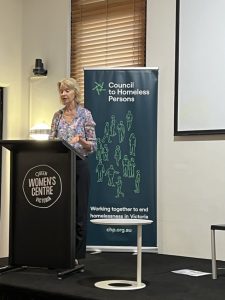Spotlight on Safe at Home in Parity special edition
For the past three years McAuley has led work exploring the damaging link between family violence and homelessness, and advocated for a ‘Safe at Home’ approach to prevent it.
This approach transforms the current default system, where women and children ‘escape’ violence and become homeless; instead they are supported to stay home safely, while ensuring accountability for the person who has used violence.
This month a special edition of ‘Parity’, the journal of the Council to Homeless Persons, explored the issue and canvassed solutions. McAuley was a sponsor of the edition and contributed several articles.
In her opinion piece, our CEO, Jocelyn Bignold, said an interest in avoiding the family violence-homelessness connection was ‘in our DNA’. She explained that McAuley was formed in 2008 with the merger of two pioneering services supporting women – one concerned with homelessness, the other with family violence.
 Experience working across both’ sectors’ demonstrated to McAuley that women were drifting into homelessness when they left family violence, and that neither ‘sector’ was seeing the connection, or working at early points to prevent it.
Experience working across both’ sectors’ demonstrated to McAuley that women were drifting into homelessness when they left family violence, and that neither ‘sector’ was seeing the connection, or working at early points to prevent it.
Ms Bignold (pictured at left at the launch of the ‘Parity’ edition) described the work of a coalition of agencies who have come together to explore the issues as ‘re-invigorating’ ‘Safe at Home’ conversations.
‘We know that just tinkering around the edges of family violence practice and policy will not bring about necessary and fundamental system changes,’ she said.
McAuley’s contribution also included an overview of a proposed trial. In an article: ‘Where to from here? Re-imagining Safe at Home’ we outlined the evidence base that had been gathered through the work of the coalition and which gives a foundation for how a dedicated program could work.
McAuley also contributed an overview of the extensive work which has taken place to consult with women who’ve experienced both homelessness as an outcome of family violence. They identified issues such as a fragmented system where it felt overwhelming to locate help, and lack of confidence in legal and policing protections if they did make a choice to remain home.
As well, economic factors – unstable employment and low income, the impacts of financial abuse, and housing affordability, all made it extremely difficult for women to even imagine a situation in which they could remain in their own homes.



